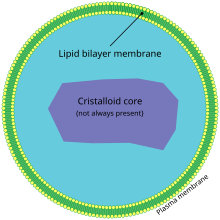|
MicrobodyA microbody (or cytosome) is a type of organelle that is found in the cells of plants, protozoa, and animals. Organelles in the microbody family include peroxisomes, glyoxysomes, glycosomes and hydrogenosomes. In vertebrates, microbodies are especially prevalent in the liver and kidney. Many membrane bound vesicles called microbodies that contain various enzymes, are present in both plant and animal cells Structure Microbodies are different type of bodies present in the cytosol, also known as cytosomes. A microbody is usually a vesicle with a spherical shape, ranging from 0.2-1.5 micrometers in diameter.[1] Microbodies are found in the cytoplasm of a cell, but they are only visible with the use of an electron microscope. They are surrounded by a single phospholipid bilayer membrane and they contain a matrix of intracellular material including enzymes and other proteins, but they do not seem to contain any genetic material to allow them to self-replicate.[1] FunctionMicrobodies contain enzymes that participate in the preparatory or intermediate stages of biochemical reactions within the cell. This facilitates the breakdown of fats, alcohols and amino acids. Generally microbodies are involved in detoxification of peroxides and in photo respiration in plants. Different types of microbodies have different functions: PeroxisomesA peroxisome is a type of microbody that functions to help the body break down large molecules and detoxify hazardous substances. It contains enzymes like oxidase, react hydrogen peroxide as a byproduct of its enzymatic reactions. Within the peroxisome, hydrogen peroxide can then be converted to water by enzymes like catalase and peroxidase. Discovered and named by Christian de Duve. GlyoxysomesGlyoxysomes are specialized peroxisomes found in plants and mold, which help to convert stored lipids into carbohydrates so they can be used for plant growth. In glyoxysomes the fatty acids are hydrolyzed to acetyl-CoA by peroxisomal β-oxidation enzymes. Besides peroxisomal functions, glyoxysomes also possess the key enzymes of the glyoxylate cycle. HistoryMicrobodies were first discovered and named in 1954 by Rhodin.[2] Two years later in 1956, Rouiller and Bernhard presented the first worldwide accepted images of microbodies in liver cells.[2] Then in 1965, Christian de Duve and coworkers isolated microbodies from the liver of a rat. De Duve also believed that the name microbody was too general and chose the name of peroxisome because of its relationship with hydrogen peroxide.[3] In 1967, Breidenbach and Beevers were the first to isolate microbodies from plants, which they named glyoxysomes because they were found to contain enzymes of the glyoxylate cycle. References
|
Portal di Ensiklopedia Dunia